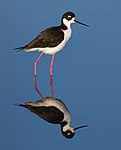American stilt
| American stilt | ||||||||
|---|---|---|---|---|---|---|---|---|

American stilt ( Himantopus mexicanus ) |
||||||||
| Systematics | ||||||||
|
||||||||
| Scientific name | ||||||||
| Himantopus mexicanus | ||||||||
| ( Statius Müller , 1776) |
The American stilt ( Himantopus mexicanus ) is a species of the avocet family . The taxonomic classification as an independent species is not undisputed. Some authors also classify the species as a subspecies of the stilt walker ( Himantopus himantopus ).
Appearance
The American stilt reaches a body length of 36 centimeters. The wingspan is 66 centimeters. There is no noticeable sexual dimorphism , but males tend to be slightly larger than females.
Basically, the American stilt is similar to the stilt common in Eurasia. Like him, he is a large, long-necked wader that appears elegant to the human observer. The long beak is very thin and straight. The top of the head and the back of the neck are black. There is a large, slightly crescent-shaped white spot above the eye. The forehead and the underside of the body are white. The legs are very long and red.
In juveniles, the top of the head and the back of the neck are also black, the top of the body and the wing covers are black-gray, the wing feathers have a light tip, which creates a light rear edge on the wings. Male juveniles have a greenish tinge on the wing covers. The legs and feet are pale gray-pink.
Head study of an American stilt walk in Berlin Zoo
Distribution area
The American stilt is found in the coastal areas of California, most of the inland areas of the southwestern United States, along the coast of the Gulf of Mexico, in Florida, Central America, the Caribbean, and in South America to northwestern Brazil, southwestern Peru, and eastern Ecuador in front. It is also part of the breeding bird population in the Galapagos Islands.
The American stilt populations further north are migratory birds that winter in the southern United States and southern Mexico. In Baja California , the American stilt can only be found in the winter months.
Way of life
The American stilt eats a wide range of aquatic invertebrates and mussels and, to a lesser extent, small fish and tadpoles as well as, exceptionally, plant seeds. He uses tidal flats, salt lakes and even flooded fields to eat.
The nests are usually no more than a kilometer from the feeding grounds. American stilts breed in loose colonies, the nests are usually about twenty meters apart. Lone brooding pairs are rare. The clutch usually comprises four eggs. The breeding season is 22 to 26 days and both parent birds are involved in the breeding. The chicks flee the nest. They are fledged by about a month of age. They breed for the first time when they are one to two years old.
supporting documents
literature
- Richard Chandler: Shorebirds of the Northern Hemisphere . Christopher Helm Publishing House, London 2009, ISBN 978-1-4081-0790-4
Single receipts
Web links
- Himantopus himantopus inthe IUCN Red List of Threatened Species 2013.1. Listed by: BirdLife International, 2012. Retrieved September 30, 2013.


